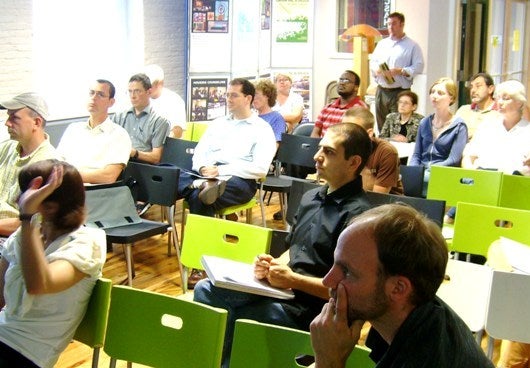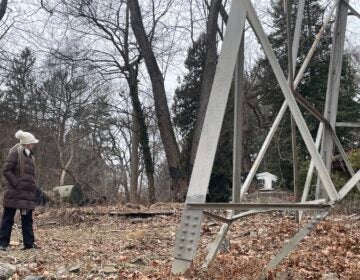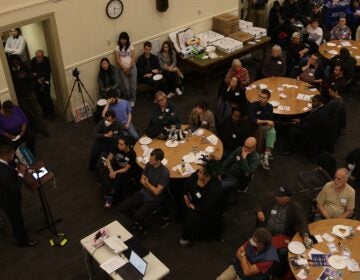Two planning visions in Kensington

June 25
By Matt Blanchard
For PlanPhilly
It was a meeting of macro and micro, a summit of destiny-minded metropolitan vision and small-scale neighborhood know-how.
Both are badly needed on the Delaware riverfront, and both were in play during Monday night’s idea-swapping session inside Kensington’s Coral Street Arts Center.
On the macro side was Penn Praxis director Harris Steinberg, commissioned by Mayor Street to produce a master plan for what he calls the Central Delaware Riverfront, seven miles from Oregon to Allegheny Avenues. With a finished plan expected by the mayor this fall, Steinberg came to the table with a “2/3rds finished” version of the much-discussed plan.
On the micro side was Joe McNulty and Sarah Corlett of the New Kensington Community Development Corporation, or NKCDC, one of several agencies giving voice to residents of the river wards, whose ancestors made their living on the river and whose children can barely get to it.
How did their visions compare?
Corlett kicked off the meeting with a 12-page draft of Neighborhood Design Guidelines for the Frankford Avenue corridor. Frankford is lately a dog-eared strip where more or less anything goes, but the guidelines foretell an end to community apathy. With requirements for scale, building materials, landscaping and curb cuts, they’ll be handed to any developer who wants to build along Frankford as a statement of the community’s aesthetic expectations.
Next up was Steinberg, whose commitment to public participation has him continually facing the crowds; he estimates some 3,000 people have heard him speak since the Praxis plan began approximately one year ago.
Steinberg tackled three disparate subjects: green space, transportation, and development guidelines.
But all three collide around the same question: How can you control what gets built along a waterfront where 90 percent of the property is privately owned, and fundamentally outside the city’s control? On Monday night, as on many nights, a member of the audience asked as much: How do you plan it if you don’t own it?
Steinberg’s answer is the core of his planning strategy: “Since this is a largely privatized waterfront, it became clear that this plan is really about putting forth a public infrastructure that will encourage quality development.”
The idea is to build everything but the buildings: Transportation infrastructure takes the form of a grand boulevard where Delaware Avenue now runs. A necklace of green spaces (a waterfront park every 2,000 feet is the ideal) will form little Rittenhouse squares around which buildings will cluster. And rather than accept the random assortment of mega-projects planned for the river today, the Praxis Plan is emphatic about chopping up large sites into a Philadelphia-scale street grid with blocks no larger than 240’ x 420’. Provide a fine-grained grid and you’ll get a fascinating, fine-grained new neighborhood.
“We’re talking about the reintroduction of the Philadelphia street-grid to an area, the riverfront, that hasn’t seen it in a long time,” Steinberg said. “There’s a back-to-the-future quality to this plan.”
Who will fund all this? Who will implement?
“This is a long-term vision, meant to create a template that the city can grow toward,” Steinberg said.
Finally, NKCDC’s Joe McNulty took over the power point projector to present the results of their “Draw Me a River” public design charrette held on June 2nd. Aware of bigger plans in the works, Draw Me a River focused narrowly on six sites that best qualify as gateways, linking the riverfront back to the neighborhoods of Fishtown, Port Richmond and Kensington.
Where Frankford meets Delaware Avenue, they imagined a traffic roundabout, a riverfront Logan Circle with ample opportunities for place-defining public art.
Where Columbia Avenue slips under I-95 to meet Penn Treaty Park, NKCDC envisioned lighting and perhaps a supermarket beneath the highway, drawing pedestrians to the park and to the mighty Peco Electric Plant, which should be reborn as a cultural facility, office or clean-energy plant.
In the tangle of roads around Aramingo and Girard, they imagined under-highway greenspaces leading down to a large park on the old Pinnacle (Cramps Shipyard) site.
Up atop the Lehigh Viaduct, a three-story high railway whose retaining walls tower over Kensington like a medieval castle, the team imagined a rails-to-trails hiking and biking path following the little-used rail line back to the Schuylkill River. At its Delaware River terminus, where mountains of Pennsylvania coal were once loaded onto ships, they would create a boat basin and preserve an early 20th century ore-loading pier as a scenic ruin.
At Allegheny Avenue, where oil storage tanks crowd around the tiny green strip of Pulaski Park, NKCDC would grow the park by annexing a Philadelphia Parking Authority impoundment lot next door. It’s hard to argue with the plan. Surely scampering children could use the river view more fully than a handful of surly attendants and 200 empty cars.
And at Frankford Creek, just south of the Betsy Ross Bridge, NKCDC found a healthy strip of abandoned land gradually returning to nature. Why not make it a wildlife refuge? And what about the Richmond Power Station, which is even more majestic than its neighbor by Penn Treaty Park? Surely it too should be preserved.
The ideas flowed until only a dozen stalwarts remained in the audience. Perhaps all this visionary planning creates more excitement than folks can handle so close to bedtime. The passion that keeps the stalwarts going was summed up nicely by McNulty in a basic statement of beliefs: “This is your neighborhood and you should be able to decide what development goes on in your neighborhood,” he said.
It’s the perfect inspiration to activism: a seemingly commonsense vision of how life should be that almost never comes to pass.
WHYY is your source for fact-based, in-depth journalism and information. As a nonprofit organization, we rely on financial support from readers like you. Please give today.






